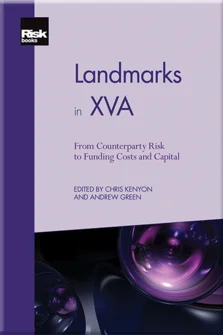Funding Strategies, Funding Costs
Christoph Burgard and Mats Kjaer
Introduction
Preface to Chapter 1
Being Two-Faced over Counterparty Credit Risk
Risky Funding: A Unified Framework for Counterparty and Liquidity Charges
DVA for Assets
Pricing CDSs’ Capital Relief
The FVA Debate
The FVA Debate: Reloaded
Regulatory Costs Break Risk Neutrality
Risk Neutrality Stays
Regulatory Costs Remain
Funding beyond Discounting: Collateral Agreements and Derivatives Pricing
Cooking with Collateral
Options for Collateral Options
Partial Differential Equation Representations of Derivatives with Bilateral Counterparty Risk and Funding Costs
In the Balance
Funding Strategies, Funding Costs
The Funding Invariance Principle
Regulatory-Optimal Funding
Close-Out Convention Tensions
Funding, Collateral and Hedging: Arbitrage-Free Pricing with Credit, Collateral and Funding Costs
Bilateral Counterparty Risk with Application to Credit Default Swaps
KVA: Capital Valuation Adjustment by Replication
From FVA to KVA: Including Cost of Capital in Derivatives Pricing
Warehousing Credit Risk: Pricing, Capital and Tax
MVA by Replication and Regression
Smoking Adjoints: Fast Evaluation of Monte Carlo Greeks
Adjoint Greeks Made Easy
Bounding Wrong-Way Risk in Measuring Counterparty Risk
Wrong-Way Risk the Right Way: Accounting for Joint Defaults in CVA
Backward Induction for Future Values
A Non-Linear PDE for XVA by Forward Monte Carlo
Efficient XVA Management: Pricing, Hedging and Allocation
Accounting for KVA under IFRS 13
FVA Accounting, Risk Management and Collateral Trading
Derivatives Funding, Netting and Accounting
Managing XVA in the Ring-Fenced Bank
XVA: A Banking Supervisory Perspective
An Annotated Bibliography of XVA
Incorporating the effects of funding derivatives into their pricing became a hot topic following the global financial crisis. Following on from earlier work by Piterbarg (2010), in Burgard and Kjaer (2011b) we established how funding costs, funding benefits and counterparty risk could be treated within one framework extending the approach of Black, Scholes and Merton. This showed that if a derivative’s issuer is able to perfectly hedge the risk of its own default, the only adjustment to the classical price is the bilateral credit valuation adjustment (CVA) inclusive of the debit valuation adjustment (DVA).
However, this would require the issuer to freely dynamically trade spread positions of different seniorities of its own bonds, and so is unrealistic. Assuming that the issuer can hedge own-default only when its derivatives position is in-the-money and so provides funding is more realistic. When it is out-of-the-money and requires funding, a post-default windfall to the issuer’s estate is generated. In that case, a funding cost adjustment (FCA) is added in to compensate.
Since the publication of Burgard and Kjaer (2011b) there has been a flurry of papers proposing alternative
Copyright Infopro Digital Limited. All rights reserved.
As outlined in our terms and conditions, https://www.infopro-digital.com/terms-and-conditions/subscriptions/ (point 2.4), printing is limited to a single copy.
If you would like to purchase additional rights please email info@risk.net
Copyright Infopro Digital Limited. All rights reserved.
You may share this content using our article tools. As outlined in our terms and conditions, https://www.infopro-digital.com/terms-and-conditions/subscriptions/ (clause 2.4), an Authorised User may only make one copy of the materials for their own personal use. You must also comply with the restrictions in clause 2.5.
If you would like to purchase additional rights please email info@risk.net











